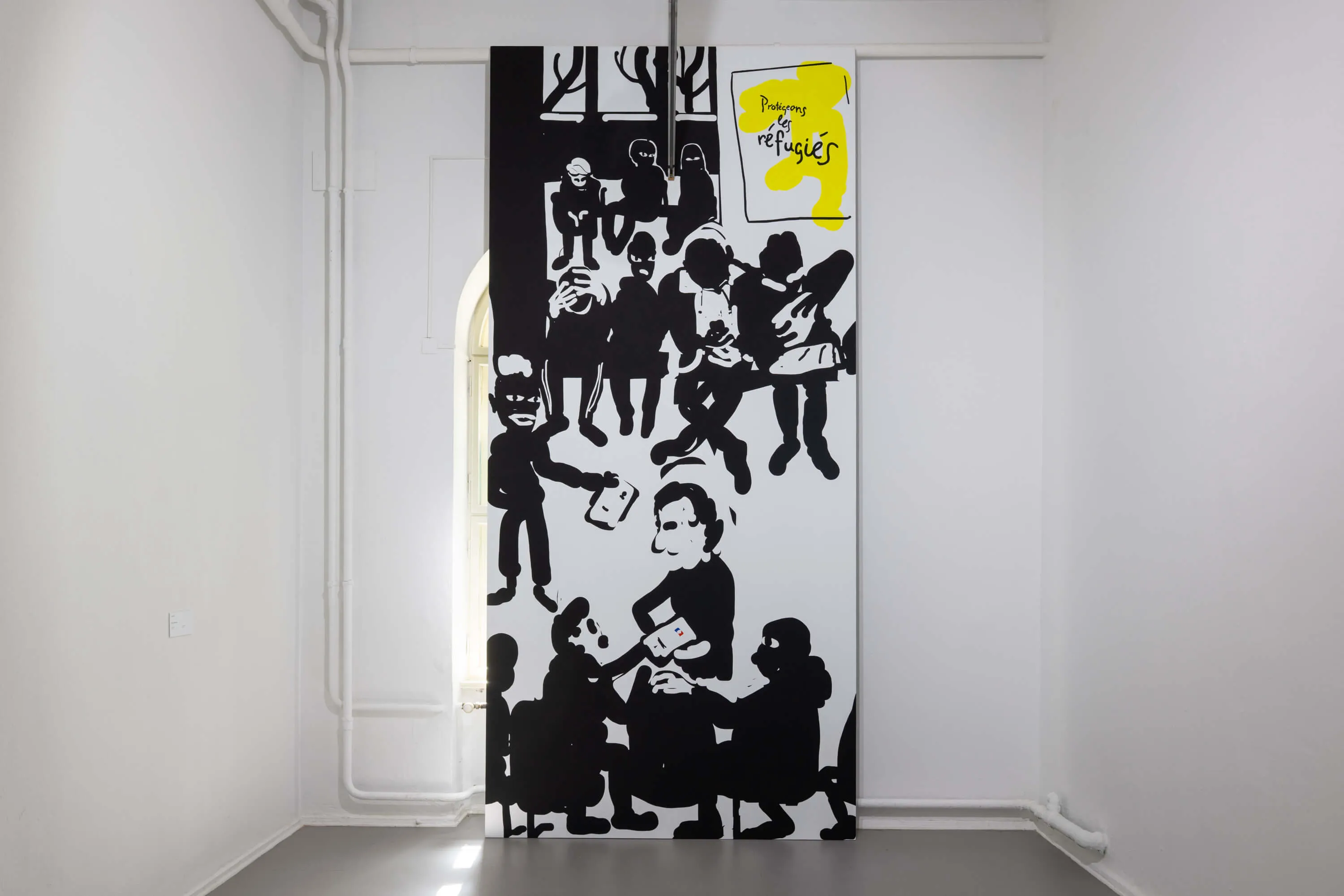Alisa Yoffe "Asylum Seekers"

Canvas, acrylic, 2025
— Tell me the history of this work.
— I arrived in Paris from Sakartvelo (Georgia) on October 19, 2023 — I left Russia on March 5, 2022 and spent a year and a half in Tbilisi — and applied for asylum. France is one of a few countries that remains open to accepting immigrants, so there are tons of people in every government department, like l’OFII (the French Office for Immigration and Integration) and l’OFPRA (the French Office for the Protection of Refugees and Stateless People). They come from all over the world and wait for their turn on the way to a new life.
In waiting rooms, I try to choose a good angle for drawing group portraits. Some people read while they wait, some look at their phones, some sleep, and some look straight ahead, as if they’re peering into eternity. I use my smartphone as a sketch pad, drawing with my finger on the screen in the Procreate app. I select a black brush and a white background — that lets me capture what I see.
[French-Soviet artist and Soviet Non-conformist Art leader] Mikhail Roginsky drew typical scenes from the everyday life of a Soviet person, like waiting in line. The work of [artists] Boris Turetsky and Semyon Faibisovich feature similar motifs. In working on this series, I keep in mind the nonconformist tradition as well as Faibisovich’s social portraits. At the same time, my group portraits of refugees are an attempt to discover myself: where am I, what am I doing, what do I look like, who am I?
— How do you transfer images from a digital format to canvas?
— I use a projector. I paint with a wide brush on the canvas, and I try to accurately convey the particular plasticity of the digital line. I work in large format. At the "No" exhibition, the room on exile has a work from the "Asylum Seekers" series that stands on the floor, taking up the entire wall and blocking a window. The people depicted on the canvas are life-sized, to the viewer — it’s as if he can enter the waiting room and take his place there.
— What does the word “exile” evoke in you? Is your emigration exile?
— The French government has declared me a refugee. A year before I left Russia, I painted murals about the imprisonment of Alexey Navalny and those arrested at protests supporting him, as well as people detained at the migrant detention center in Sakharovo. Since February 2021, before the war started, I’ve been publishing anti-war statements and drawings. In Russia, I would be arrested and thrown in prison, and I already dedicated my 2017 exhibition "Lawlessness", in Voronezh, to torture in prisons.
Since the beginning of my artistic career, I’ve worked with social and political themes and spoken out against the war in Ukraine. I refused to be silent and live in Russia just waiting for prison, paying taxes that fund the war. Perhaps my situation can be called exile — a "second exile", because as a teenager I already went through emigration, with all the bureaucracy, adaptation, integration. I was born in Uzbekistan, and I left with my mother and grandmother in 2000: it became frightening to stay there because of burgeoning nationalism. We spent three and a half days on the train, crossed Kazakhstan, where we lost a portion of the money we’d gotten from selling our things — we paid it in bribes to Kazakh border guards, who made a living by going from compartment to compartment demanding money. Sometimes they said people had overweight luggage — with us, it was because my grandmother didn’t have Russian citizenship; they threatened to throw her off the train.
I’m not Uzbek, but in school in Russia I got called "Uzbek" or "Jew". I know how hard it is for immigrants from Central Asia to live in Russia. Russia is harder on migrants than France is. I’m not losing my homeland now, that happened long ago. But was Uzbekistan my homeland? Or were Russian speakers there occupiers, like we are in Sakartvelo?
Alisa Yoffe works in a very recognizable style: a minimalist black and white palette, broad brush strokes, deliberately nonchalant, but very legible images. This style, often found in traditionally analog media like graphic arts and painting, has migrated organically into digital art over time.
The drawings that Yoffe composes on her mobile phone look like hand-drawn work, in no way resembling the "perfected" images and symbols we’re accustomed to seeing on our gadget screens. Thus, the artist humanizes a cold digital environment. Yoffe transfers some of her drawings to canvases and walls — again, by hand — alongside random artifacts, like fragments of erased lines.
Alisa Yoffe was born in 1987 in Tashkent, Uzbekistan. She studied at the Free Workshops at the Moscow Museum of Modern Art, the Institute of Problems in Contemporary Art, and under the artist Anatoly Osmolovsky.
Yoffe’s work has appeared in the most famous Russian art markets, Cosmoscow and Blazar. Her work has been exhibited at solo shows in Russia, Germany, Italy, the Netherlands, and Sweden. The artist’s work is also held in the collections of the Tretyakov Gallery, the V-A-C Foundation, the Perm Museum of Contemporary Art, and the Phoenix Art Museum. Alisa was nominated for the Joseph Brodsky Memorial Fellowship Fund (2017), the American Academy in Rome (2017–2018).
In addition to her solo projects, Yoffe is known for collaborations with a number of famous brands, including Comme des Garçons and Cartier. She has also worked with the Georgian humanitarian center Choose to Help, which aids Ukrainian refugees. The artist left Russia at the beginning of the full-scale invasion of Ukraine. She now resides and works in Paris.